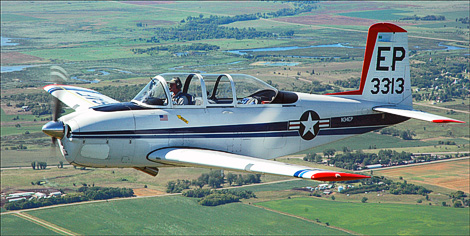|

T-34A N34EP (s/n 53-3313), flown by Jim Skogen of Minnesota,
USA.
Photo by Max Haynes, MaxAir2Air.com.
History: The Model 45
primary trainer was based on the successful civilian Beech Model 35 Bonanza. Although
first built in 1948 in response to an expected demand by the Air Force, a fly-off
competition was required before the decision was made to purchase it. At this time the
USAF was trying to figure out the best way to train new pilots; whether to have them start
in jets or use piston-powered craft for the transition phase of training. The latter
choice was made and in March of 1953 the Model 45 was selected under the designation T-34
Mentor. Eventually a total of 450 T-34As were
built for the Air Force. A year later the first of 423 T-34B
trainers were delivered to the U.S. Navy, these with increased horsepower.
Consideration was given to arming the craft with machine guns
and bomb racks for a potential close support role, but no orders materialized. Eventually,
most piston engines were phased out in favor of an all-jet training regimen. However, the
Navy decided in 1973 to buy 184 T-34’s with upgraded turbine power. This allowed the
service to keep the tried and true Mentor airframe, with its excellent and forgiving
handling qualities, while providing students with the required experience. The first T-34C
Turbo-Mentor began student training in January 1978 and production of this
model reached 353. A number of countries have purchased a variation of this model to
provide forward air control and tactical strike capability. Japan licensed and built the T-3
version of the aircraft, and also built a four-seat liaison version (LM-1/LM-2),
often informally referred to as the "Fuji."
After their retirement from active duty with the US Air
Force, many Mentors went on to serve with the Civil Air Patrol as spotter and
general-purpose utility aircraft. About 100 of the 1,300 T-34s built still remain in
military service today.
In the last twenty years, the T-34 has developed an
extremely loyal
following among warbird owners and operators, with well over a hundred now in private
hands. Its good looks, maneuverability, and relative economy of operation have captured
the interest of the warbird community, and it promises to live on for generations to come.
Nicknames: "The Radial
Interceptor"; Komadori ("Robin") (Japanese Air Self-Defense Force
nickname for Fuji-built version called the T-3); Harukaze ("Spring
Breeze") (Japanese Ground SDF nickname for LM-1/LM-2 Nikko four-seat liason version.)
Specifications (T-34B):
Engine: One 225-hp Continental O-470-4 flat-six piston engine
Weight: Empty 2,055 lbs., Max
Takeoff 2,900 lbs.
Wing Span: 32ft. 10in.
Length: 25ft. 10in.
Height: 10ft. 0.25in.
Performance:
Maximum Speed:
188 mph
Range: 770 miles
Armament: None
Number Built: 1,300+
Number Still Airworthy: 400+
 [
Flight Report by Budd Davisson ]
[
Flight Report by Budd Davisson ]
 [ T-34 Photos ]
[ T-34 Photos ]
T-34 Cockpit Photo:

(Click for larger)
Links:
Lima Lima Team
North American Trainer Association
(NATA)
T-34 Association
T-34 Regulatory
Issues (on AOPA site)

[Back to Warbird Alley's Main
Page]
All text and photos Copyright 2016 The
Doublestar Group, unless otherwise noted.
You may use this page for your own, non-commercial reference purposes only.
 |